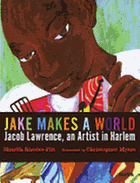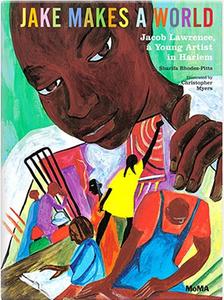
 For the first time since 1993, all 60 panels of The Migration of the Negro series by Jacob Lawrence (1917–2000) are reunited at New York's Museum of Modern Art. Lawrence created the series in 1941 at the age of 23; the odd-numbered panels are in the Phillips Collection's permanent holdings, and the even-numbered panels are part of the MoMA's permanent collection.
For the first time since 1993, all 60 panels of The Migration of the Negro series by Jacob Lawrence (1917–2000) are reunited at New York's Museum of Modern Art. Lawrence created the series in 1941 at the age of 23; the odd-numbered panels are in the Phillips Collection's permanent holdings, and the even-numbered panels are part of the MoMA's permanent collection.
Sharifa Rhodes-Pitts (Harlem Is Nowhere), in her first book for young people, commemorates the occasion by describing the awakening of the young artist at 13, when he moves to Harlem from Philadelphia, with illustrations by Caldecott Honor artist Christopher Myers (Harlem, written by his father, Walter Dean Myers, to whom this book is dedicated). "In the morning Jake watches the sun wake up," Rhodes-Pitts writes. "He makes a big stretch, and the sun stretches, too." In Myers's accompanying painting, Jake's arms dance above his head; the colors of the sunrise appear in the striped quilt on his bed.
The author's lyrical words reflect an artist's view of the world. Jake's feet sink deep into a thick blue rug: "When his toes touch the ground, it's like a sky upside down." Myers skillfully pays homage to Lawrence while retaining his own style. A preacher in a bright blue suit stands in front of row houses bathed in sunlight, recalling Lawrence's Brownstones (1958). Jake reaches toward Utopia Children's House, where he first met artist and teacher Charles Henry Alston. In one of Jake's paintings, "all the faces" he sees on the street "become one face," and after his teacher shows him an African mask, Jake fashions his own from brown paper bags, glue and paint.
Author and artist draw a direct correlation between the people and the places that shaped Jake and how they find their way onto his canvas. As Jake re-creates his street (in the image featured on the cover), Myers invents a glorious mash-up of Lawrence's foreground figure from Carpenters (1977) and images from the Migration Series: the center girl from Panel 58, and a barred grate that evokes a ticket counter [Panel 12] or jail cell [from Panel 22]. In the closing image, Myers depicts Jake deep in thought, as if imagining what's to come, in a kind of elaborate collage composed of reproductions from the Migration Series and 1938's Dust to Dust (The Funeral).
Rhodes-Pitts and Myers imagine a young artist called to his vocation, who honors his city and history as subjects worth capturing for posterity. A fine introduction to a boy who would grow up to immortalize his era.
Shelf Talker: Sharifa Rhodes-Pitts and Christopher Myers capture the childhood of artist Jacob Lawrence, who would grow up to immortalize his era.

